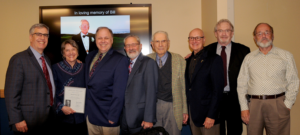William Spencer, MD
Grateful thanks to Bruce Spivey, MD, and Denise Barsness, CRA, COMT, CDOS, FOPS

Our residency program was hugely impacted by the scholarly contributions of Bill Spencer, a renowned ophthalmic pathologist. Spencer’s brilliance enriched both faculty and residents, giving us status nationally and internationally because of his eminence and membership in such organizations as the Verhoff Society, the AOS, AFIP, the Canadian Ophthalmic Pathology Society, Cogan Society, EOPS, the Western Pathology Club, the AAO and his leadership of the American Board of Ophthalmology.
His enthusiasm for ophthalmology was lifelong, beginning in childhood when an uncle treated him for a hypermetropic accommodative squint. Bill learned how lenses worked and he went on to study the basic principles of optics on a bench his uncle had fashioned to study for his own American Board of Ophthalmology examinations in the 1920s – the very exams Dr. Spencer would go on to oversee, first as a director, then decades later, as the organization’s Executive Director.ollowing his graduation from the Bronx High School of Science, Bill Spencer served in the Army, was wounded in the Battle of the Bulge, earning a Purple Heart. He went on to study optometry at the University of California Berkeley before earning his medical degree at the University of California School of Medicine San Francisco. He completed his ophthalmology residency at UCSF, and a Heed Fellowship in ophthalmic pathology at the Armed Forces Institute of Pathology in Washington, D.C.
During his early years in San Francisco, he interacted actively with a veritable “who’s who” of Bay Area pioneer sub-specialists including Drs. Max Fine (corneal transplantation), Dohrmann Pischel (retinal surgery), Bob Shaffer (gonioscopy and glaucoma), David Harrington (perimetry), Crowell Beard (plastic and orbital surgery), Art Jampolosky (strabismus), Phillips Thygeson (external disease) and Mike Hogan, (ophthalmic pathology). He joined the faculty at UCSF from 1959 to 1972, going on to the University of Southern California as the Estelle Doheny Professor of Ophthalmology and as Medical Director of the Doheny Eye Foundation.
In 1975, he was recruited by Bruce Spivey to return to San Francisco as the Gellert Professor of Ophthalmology and director of the pathology laboratory. Spivey recalls that Spencer took time to teach and worked with residents in preparing papers but, “his teaching was not always easy for the residents to incorporate into their brains, but he kept trying,” adding that “Spencer’s quiet presence was a good offset to the rather frenetic activity of Spivey, Stamper, et al.”
Spencer published extensively throughout his life and delivered numerous named lectures, including the Jackson Memorial Lecture at the AAO annual meeting in 1978. A history enthusiast, Dr. Spencer was also the curator for the Academy Foundation’s Oral Histories Program.
As a director of the American Board of Ophthalmology, Spencer participated in the earliest discussions on recertification in the late 1970s and served as board chair in 1981. Serving as Executive Director of the ABO from 1986 to 1995, he oversaw the introduction of time-limited certifications, the evolution of the Patient Management Problem (PMP) along with the question format of the oral examination and the organization’s 75th anniversary.
Spencer was the editor for the 3rd Edition of a 3-volume text on ophthalmic pathology, known as “The Blue Atlas,” which was recognized as one of the “100 most important ophthalmology books of the 20th century” by Drs. H. Stanley Thompson and Donald L. Blanchard in a compilation by Iowa University Hospitals. The images for the book came from Spencer’s methodically catalogued cases, and CPMC’s Michael Coppinger did all the hand printing of the original images. When a 4th edition was published in 1996 using digitized images, Spencer was greatly disappointed, feeling they were far inferior. He always referred to his 3rd Edition as the finest one. Spencer’s original images for that book can now be found at UC Davis.
William Spencer is remembered as a true scholar, walking encyclopedia of ophthalmic knowledge. Well into his 90’s he was still an active participant in Grand Rounds and at the conclusion of one presentation he was heard to say with delight, “I really learned something new today!” Until extremely late in his life he continued to work with Denice Barsness on cataloging his immense slide collection.
He was personable, and loyal and while he was not particularly easy on his students, he evoked enormous respect and love. See Bernd Kutzscher’s photo and story about skiing with Dr. Spencer in our Alumni Stories section.https://barkansociety.com/bernd-kutzscher/

Dr. Spencer’s son Jonathan, third from left at the annual Spencer Lecture with Drs. Denny, Day, Stamper, Jampolsky, Stewart and Colenbrander
